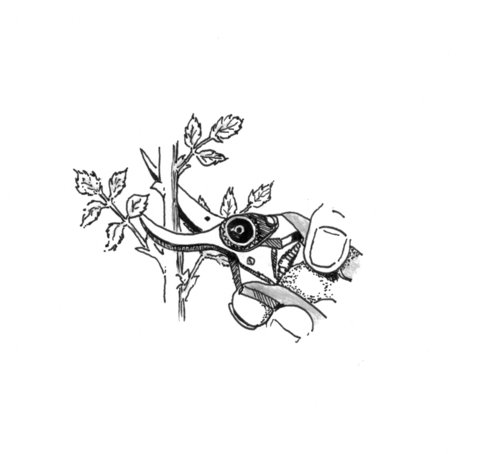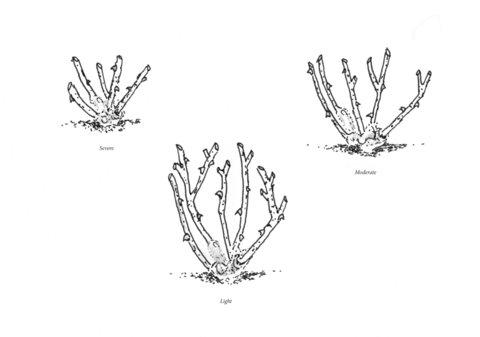

Annie, Pickles and the organically grown, man-eating, fence-bending white Lady Banksai climbing rose. (Courtesy Bill Buzbuzian)
Excerpted from Talking Dirt: The Dirt Diva's Down-to-Earth Guide to Organic Gardening (Penguin Group) Author: Annie Spiegelman
Here in California, I usually prune my 20-some rosebushes on New Year's morning. Being out in the fresh air works wonders for a cheap-Champagne-induced hangover. For those of you in colder climates, wait till late March or April. If you're new to growing roses and not sure when to prune, check with your local garden nursery. There's no foolproof answer for when to prune but a good rule of thumb is to prune when dormancy is broken (you'll see new growth, especially budding eyes, which are red swollen dots on the major canes) and there's no threat of another hard freeze.Pruning roses helps speed up nature's growth cycle. It permits good air circulation and allows the plant to concentrate its energy on the remaining healthy shoots.
If time permits, 2 weeks before you prune, remove all the leaves off of your rosebushes gently. Cutting them off works better than stripping and pulling. This will signal the plant to rejuvenate the foliar process. You'll also be able to see more clearly the swollen red eye, where new growth will form. This is where you will make your cut.
Pruning Roses:
Tools You Will Need:
Pruning shears
Loppers (for large, thick canes that pruning shears won't get through)
Gloves
Guts
General Rose Pruning Steps
(Safety note: Always wear gloves.)
1. Remove any dead wood or old canes.
2. Cut out any weak, spindly, or deformed growth.
3. Remove any canes growing toward the center of the bush. (Aim to form an urn shape.)
4. Remove any suckers. (Undesired skinny shoots that grow up near the bud union (the bulbous center of the rose) usually a slightly different foliage color. Suckers are losers and will drain energy away from the main canes.)

(Illustration courtesy of Maggie Agro)
Pruning Note:
Severe pruning will produce fewer but showier blossoms. I like to prune moderately which means that each rosebush is left with four to eight canes, about 24 inches high with airy space in the center of the bush. Light pruning will produce many blossoms on shorter stems.If you're new to pruning rosebushes, prune lightly the first year and see how you like it.

(Ilustration courtesy of Maggie Agro.)
Last, there's always been some disagreement among rosarians about when to prune English roses and old roses: early winter or late summer? There's nothing more fun to watch than squabbling rosarians, is there? Most rose experts agree that modern roses and most English roses should be pruned in the late winter, whereas old roses should be pruned after they bloom in the summer. That's my story and I'm sticking to it.
World renowned rosarian, David Austin himself writes in his book, The English Roses, "With relatively mild winters, late December to early February are the best times to prune. In regions with cold winters pruning should be delayed until spring growth is just starting."It's also best not to prune old roses for the first three years and after that to prune lightly after bloom in the summer. Try it out and see what works best for you.
Climbing roses require only minimal pruning if any at all for the first few years. Just remove dead or spindly wood. After that, once the vigorous, mature climber starts taking over the neighborhood, don't be afraid to prune back many side shoots and a few main canes by half just to keep the shape and size from damaging your fence.
If the idea of pruning your roses is making you nervous, I'll let you in on a deep, dark rose secret: It will set you free. Pruning trials conducted by various rose societies consistently showed that rough pruning with a hedge trimmer produced results as good, or better, than traditional pruning methods. Take that, you hoity-toities! Take a deep breath and have faith you can do this. Once you get warmed up, you'll be unstoppable. Shazaam!
Rose Lingo:
Types of Roses the Snooties Like to Talk About with Their Pinkies Up
Hybrid Tea: Usually has one large, scented, single flower to a stem, on a plant 3 to 5 feet tall. Blooms repeatedly throughout the summer; has a pompous air about it. Walks like a poodle.
Polyantha Short: compact plant with many smaller flowers growing in clusters. Blooms over a long period; are easy to grow.
Floribunda: Cross between a hybrid tea and a polyantha. Hardy and compact with medium-size flowers growing abundantly in clusters.
Grandiflora: Can grow to 6 feet tall with large flowers in long-stemmed clusters from summer through fall.
Climbers: Have long flexible canes that can be attached to fences, posts, and arbors and can grow 10 to 20 feet long or more. Most are fast climbers, easy to grow, and require minimal pruning.
Miniature: Pip-squeaks. Easy to grow, and good in pots on decks. Happy to serve; rarely make a peep.
Shrub: More shrub-shaped than urn-shaped; usually larger and wilder than other types. Tend to be hardy and disease resistant. A great choice for novice rose growers.
Old Roses: (Heritage, Antique) Some of the most common are alba, damask, Bourbon, China, gallica, and Noisette. Old-fashioned looking, taking you back in time. Scented and splendid but many just bloom once in the spring, sometimes offering a second less-dramatic flush in the summer.
English Roses: Have the characteristics of the new roses--repeat blooming and sturdy--with the heavenly old-fashioned fragrance and whimsical charm of old roses. (Available from David Austin Roses at www.davidaustinroses.com.)
Become a member of the Dirt Diva Royal Horticultural Society at www.dirtdiva.com
